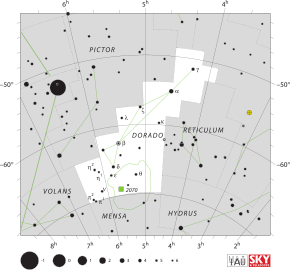
Back Swaardvis (sterrebeeld) Afrikaans أبو سيف (كوكبة) Arabic دورادو ARZ Qızıl balıq (bürc) Azerbaijani Алтын Балыҡ (йондоҙлоҡ) Bashkir Залатая Рыба (сузор’е) Byelorussian Залатая Рыба BE-X-OLD Златна рибка (съзвездие) Bulgarian Aouredenn (steredeg) Breton Zlatna riba (sazviježđe) BS
| Constellation | |
 | |
| Abbreviation | Dor |
|---|---|
| Genitive | Doradus |
| Pronunciation | /dəˈreɪdoʊ/, genitive /dəˈreɪdəs/ |
| Symbolism | the dolphinfish |
| Right ascension | 5h |
| Declination | −65° |
| Quadrant | SQ1 |
| Area | 179 sq. deg. (72nd) |
| Main stars | 3 |
| Bayer/Flamsteed stars | 14 |
| Stars with planets | 5 |
| Stars brighter than 3.00m | 1 |
| Stars within 10.00 pc (32.62 ly) | 0 |
| Brightest star | α Dor (3.27m) |
| Messier objects | 0 |
| Meteor showers | None |
| Bordering constellations | Caelum Horologium Reticulum Hydrus Mensa Volans Pictor |
| Visible at latitudes between +20° and −90°. Best visible at 21:00 (9 p.m.) during the month of January. | |
Dorado (US: /dəˈreɪdoʊ/, also UK: /-ˈrɑːdoʊ/) is a constellation in the Southern Sky. It was named in the late 16th century and is now one of the 88 modern constellations. Its name refers to the mahi-mahi (Coryphaena hippurus), which is known as dorado ("golden") in Spanish, although it has also been depicted as a swordfish. Dorado contains most of the Large Magellanic Cloud, the remainder being in the constellation Mensa. The South Ecliptic pole also lies within this constellation.
Even though the name Dorado is not Latin but Spanish, astronomers give it the Latin genitive form Doradus when naming its stars; it is treated (like the adjacent asterism Argo Navis) as a feminine proper name of Greek origin ending in -ō (like Io or Callisto or Argo), which have a genitive ending -ūs.